

Rhino Northern California recently wrapped up a testing run of work dates in San Francisco’s Golden Gate Park. In the days following, three of those involved took time to answer some questions about the experience. They are: Jessica Saling, Director of Operations; Mike Andrews, Scheduling Coordinator; and Sam Zimmerman, Supervisor.
Staying Fit and Sharp
Your first work date for the Dead & Co., Outside Lands, and Zach Bryan run of shows in the Park was on July 7th and from July 23rd thru August 20th you had a daily presence in the park. There seem so many challenges you might face during such a run, but let’s start with the stamina required for such a run of working days. How did you manage to keep yourself physically fit and mentally sharp for such a run and what did you do to ensure your team members could do the same?
Jessica: We made an effort to nourish ourselves regularly, checking in with each other at meal and break times to ensure we were comfortable “walking away” and rotating leadership duties for a period of time. Personally, I have a physical trainer and yoga teacher I preschedule private classes with throughout the run. I have done this for many years now, and it really helps me stay active and stretched in a focused way during the chaos.
Mike: To stay physically fit and mentally sharp during the demanding run of shows, I focused on maintaining a regular sleep schedule, eating a healthy diet, and taking daily walks. For the team, we provided rotating days off whenever applicable to help them rest and recharge. We also tried to schedule regionally as much as possible to minimize additional commute hours on top of their long workdays.
Sam: It is important to separate one’s self from the festival when not on the clock. It is so easy (and honestly, vital) for the supervisor to take on the stress of the festival as your own, however, once my last crew was cut, I was truly done with the festival for the day. This left me with an hour or two of me-time per day which I used to immerse myself in the things I love outside of live music. By giving myself this time, I was able to relieve myself of that stress on a nightly basis and prepare for the days to come. I would always check in with the crew first thing in the morning to make sure everyone was rested and ready for work and if they didn’t seem to be, I would make sure they were either on the over-the-call list or moved to a duty with a low risk of harm.
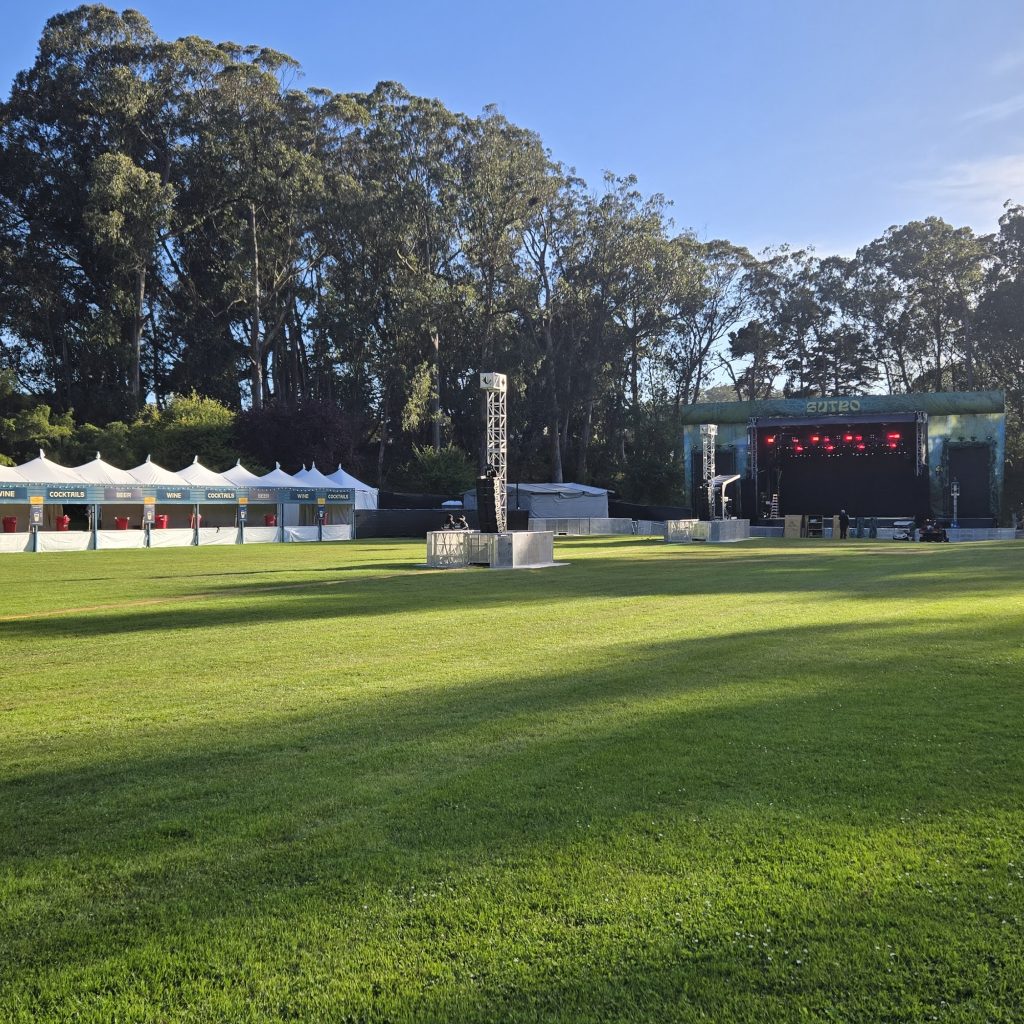
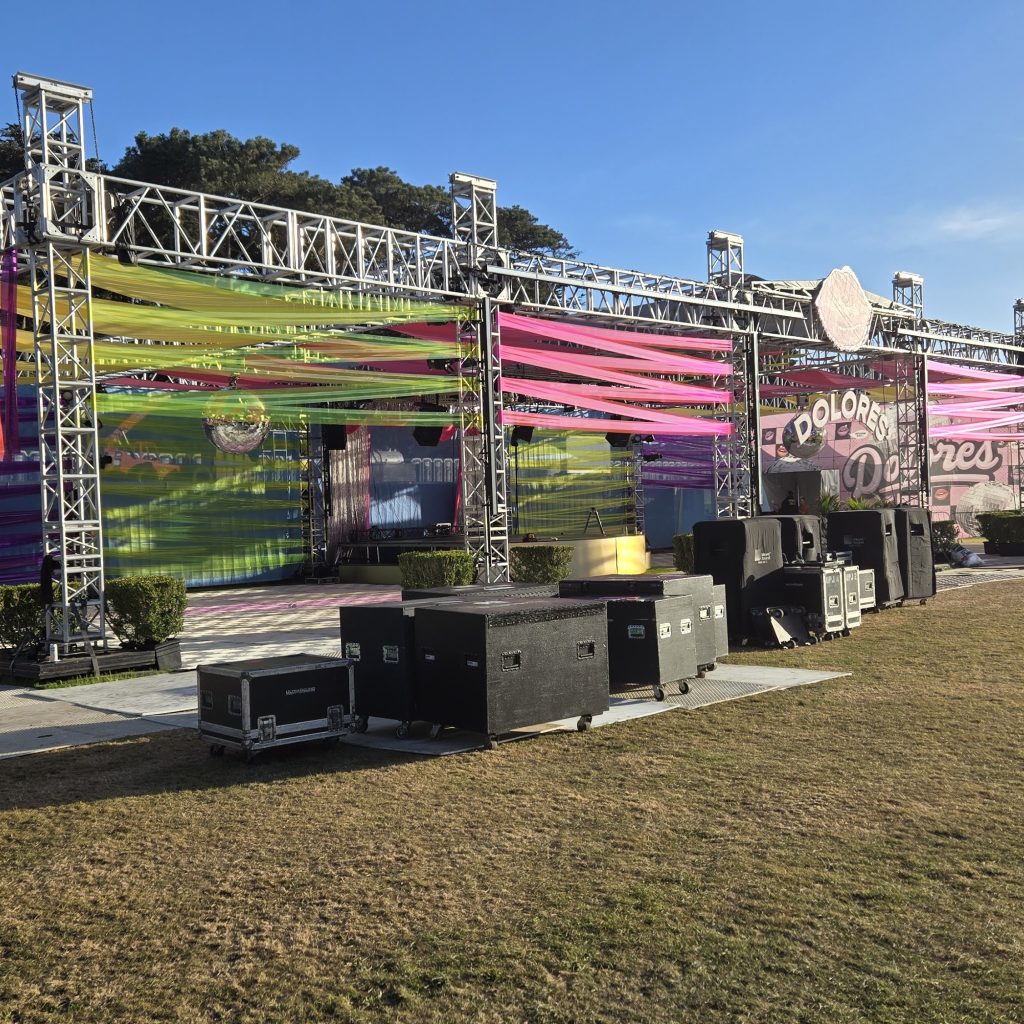
Large Site Challenges
Another daunting aspect of this is the sheer size of the event site. At 80 acres (or just over 105 football fields) you and your teams are often well out of sight or sound of each other. Of course, radios and golf carts help in coping with that size, but, even so, what are the particular challenges of coordinating with your teams across all the satellite locations and how did you meet them?
Jessica: We try to assign a team leader and the buddy system to crews that will be out in the park for a good amount of time. Our Site Supervisors are in consistent communication with the client leads to ensure movements happen effectively.
Mike: Keeping meals and break periods on time can be challenging, especially when calls start at separate times, day or night. Adding a supervisor-minded person to each call, along with maintaining a consistent crew, has been effective in establishing a game plan and executing communication. Site supervisors and golf carts help maintain accurate timing, ensuring employees return from meals and breaks on time and ready to continue working.
Sam: Every crew has a leader, either explicitly designated on the timesheet or assigned by me in the morning. Whenever possible, I would assign our golf carts with crew sizes that closely match the seat counts in those carts. Fortunately, we have lots of employees who want more responsibility, so figuring out who that leader should be was never an issue. Even still, there were occasionally times that someone would wander off.
A moment that encapsulates the difficulty: During a barricade call, an employee went to use the restroom. He didn’t tell anyone, and it seems that he may have been in there for longer than would typically be reasonable for a bathroom break. I received a call from the Rhino lead for that crew, letting me know that he was missing and that they had to move on to another site. About 15 minutes later I got a call from the missing employee – surprise surprise, he was confused where to go. This just goes to show that despite best practices there will always be some issues with coordination.
Working Outdoors
More challenges are presented by the fact that the site is outdoors on natural and hilly terrain and is part of the much larger Park ecosystem of over 1000 acres. It seems that coyotes and even mountain lions sometimes roam the park. What are some of the unique issues that present in such a work setting and how did you cope with them?
Jessica: Since we are in a park on the beach and in a residential neighborhood, we keep an eye out for everything and pick up after ourselves consistently. The Polo Fields and tree lines are approached with particular care.
Mike: Some of the unique challenges include looking after the park in every aspect, such as the wildlife, grass, tree branches, and walking trails. And trying not to leave a lasting footprint of the heavy build. Uneven work surfaces are identified in pre-trip inspections by our site supervisor and operators, as conditions and access can change daily.
Sam: One crew almost accidentally hit a pair of coyotes on a cart, and another employee asked me to stop the golf cart to try and pet another. That was a “no” from me. I can attest, they’re no joke out there!
Beyond the local fauna, most people are also not used to working around sensitive flora. I always try to remind equipment operators to make sure they know where their machine is allowed to exist but there are always so many cooks in that kitchen and every year there is at least someone who makes that mistake. Operators are also not used to watching above them for low hanging branches, it is important to keep them mindful of that reality in the park.
While not necessarily unique to Outside Lands more than any other outdoor festival, it is vital that all barricade crews wear gloves to protect against the surprise pinch-points that the uneven ground creates.
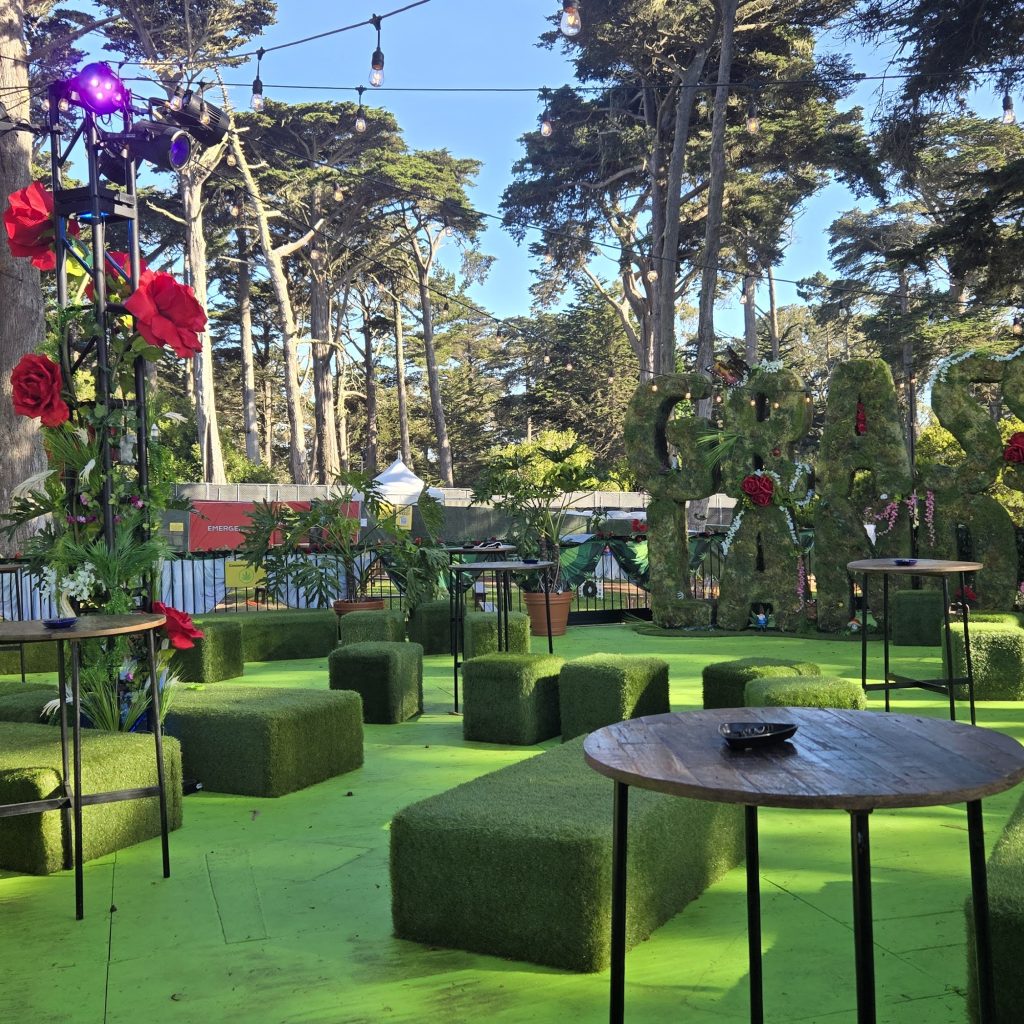
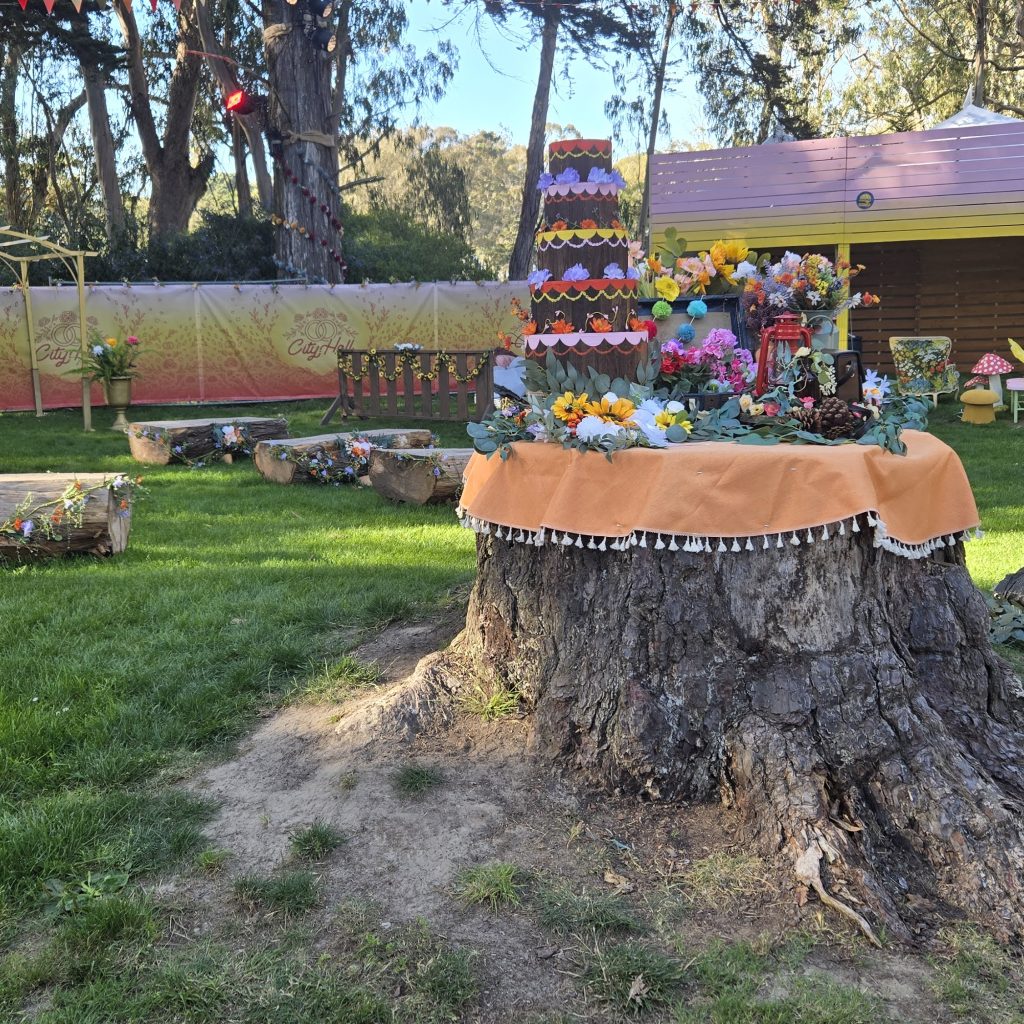
Days and Nights in a Widely Variable Climate
Work went on day and night throughout the run of days in a summer-time climate where high and low daily temperatures can vary by up to 20° F. Was that a particular challenge for you and your teams and, if so, how did you overcome it?
Jessica: Layer up! We provide different options to help, such as cooling rags, electrolytes, and hand warmers. Our field notes are pretty extensive for this project.
Mike: The weather in the park can be pretty unpredictable! Even on a sunny day, temperatures can drop quickly, and it might get cold and drizzly in a matter of minutes. Reminding the crew to bring a jacket with them every day. Also, identifying slip and trip hazards is high on the list for after-hours calls. Staying vigilant in pointing out any potential traction hazards for the equipment is also crucial.
Sam: This being my eighth year in the park, I don’t even check the weather forecast anymore. Instead, the best practice is to simply prepare for every kind of weather you ever see in the park. I typically wear three layers – a t-shirt, some kind of over-shirt, and a light semi-waterproof jacket. I keep a raincoat in the office in case of actual stormy weather, but that has only been an issue once – in 2021 when we held the festival in October.
Beyond apparel, I noticed that employees tend to rely on Rhino for things like sunscreen more than they should. I’m torn on this – on one hand I want to make sure everyone is safe and comfortable, but on the other I want to create a greater sense of self-sufficiency. There were several times that employees would leave their worksite to come back to the office and reapply sunscreen which could easily be avoided by employees having their own basic supplies.
Integrating New Team Members
You all have years of working experience with the Park as an event site, as did many of your fellow Rhinos working with you there. But with a surge of work like this, you also deployed newer employees. How did you attempt to see that they were integrated into the teams and mentored by the more experienced personnel?
Jessica: We couldn’t do this project without new Rhinos. It is their enthusiasm and interest levels that keep the returning employees on their toes. They help us avoid complacency. You always need to be able to explain the ins-and-outs to someone and that helps keep the information fresh. This is a great training ground.
Mike: Integration of new employees starts with scheduling. We implement the mentorship program, providing each call with a balance of experienced and new employees. Conditions can change on site, so we entrust our site supervisor with assessing talent and re-blending crews as needed.
Sam: In an industry such as ours, there is a lot of jargon. Because of this, it’s easy to quickly suss out a person’s experience level based on their reaction to hearing those words, which, in turn, allows me to make sure that each squad had some sort of leadership. By mixing newer employees in with the leaders amongst our crews, we were able to get several hands ready to help out with stage loading on the show days, not an unimpressive feat considering they first heard about us in June!
Off-Site Support
No doubt there was a great deal of behind-the-scenes support for the teams in the field. Tell us a little bit about that.
Jessica: Scheduling Coordinator Noelle McBride does timesheets at 5 am almost every day so that I can produce daily invoices by noon. Mike schedules nonstop starting about 2 weeks before our first day on site. He tries to have the next day’s crew list as solid as possible so that we can provide the multitude of timesheets to our on-site team for printing before they leave for the night. The onsite supervisors are diligent about uploading all documents from the day, such as timesheets, incident reports, and employee notes, before they go for the day. Somehow, between the 5 of us we get it all done with changes typically coming in between 17:00-21:00 from the clients.
Sam: I absolutely could not have done this without the support of Jess, Mike, and Noelle. Every morning we would discuss the status of the crews, who was late, what calls have been adjusted on site, what calls have been adjusted off site, etc. There was a tremendous amount of trust on both sides of those conversations which allowed everyone to do the work they needed to do, from calling in reinforcements from offsite to chasing down employees who had just been cut but were now needed again. I believe only two calls were ever short on people, which puts us well over 99% staffed for the run.
Performances of Note
Are there any individuals or teams you would like to give a shout-out to for their work during this run?
Mike:
- Road Crew – No missed days by any of the 7 core individuals is truly unbelievable. All-Time OSL – Champions. 🥇
- The Hit Squad, Quartermaster and Barricade teams – They worked in silence, but carried a lot of weight. Their years of on-site experience keep the festival moving when no one is looking.
- Sam Zimmerman, Site Supervisor – Excellent leadership skills, calm demeanor, and site familiarity made him one of the best choices to ever run this project.
- Tobin Davis, SAF & all-around team player – The crew runs better when he’s around.
- Honorable mentions for new employees Emiliano Gomez and Alicia Aguliar. They raised the bar.
- And last, but not least, Jessica and Noelle for trusting the method to my madness with scheduling and being supportive in every way possible.
Sam: Oh man, here we go! This is by no means an exhaustive list, but I’ll focus it on my leaders to avoid making this a 30 page document.
- Austin Jeurgins – Absolutely blown away with the leader that he has become. There is LITERALLY nothing I would change about his performance as barricade lead this year.
- Willie Williams – Another employee who has shown tremendous improvement. One of my go-to guys for the whole run when I needed a leader.
- Tyler Mosby-Barto and Jeffree Souza – A great team who took appropriate responsibility for themselves for the whole run and made my life as easy as they could. This isn’t surprising, they’ve been great for a while now.
- Amy Fisher – Amy went into this run as the Quartermaster (QM) float position, which involves assisting each of the three QM departments (site supplies, heavy equipment, and golf carts) when needed. However, the lead of the site supply department was unable to perform the tasks required of her, and she quit on the first day of the run. Fortunately for Quartermaster Mike Bloomquist, Amy was ready to step up into that role at a moment’s notice and manage the entire festival’s worth of site supplies. I cannot overstate how valuable she was to the festival.
- Tobin Davis – I firmly believe that T-Bone is the safest Rhino that the NCA market has. There is no better choice for making sure that everyone gets home safely, and he did just that.
As I mentioned before (and likely will again), the support from Jessica, Mike, and Noelle is what made my success possible.
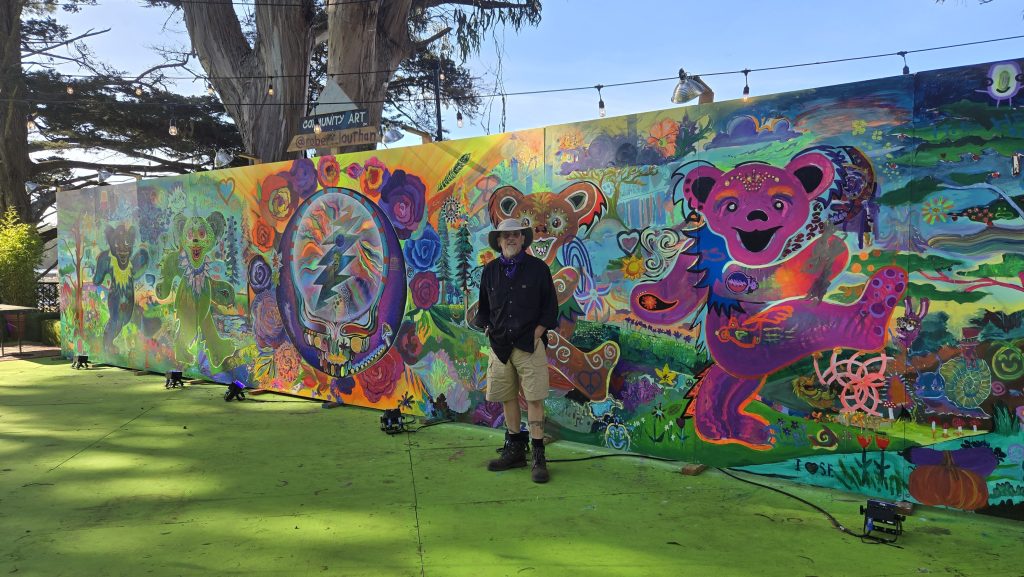
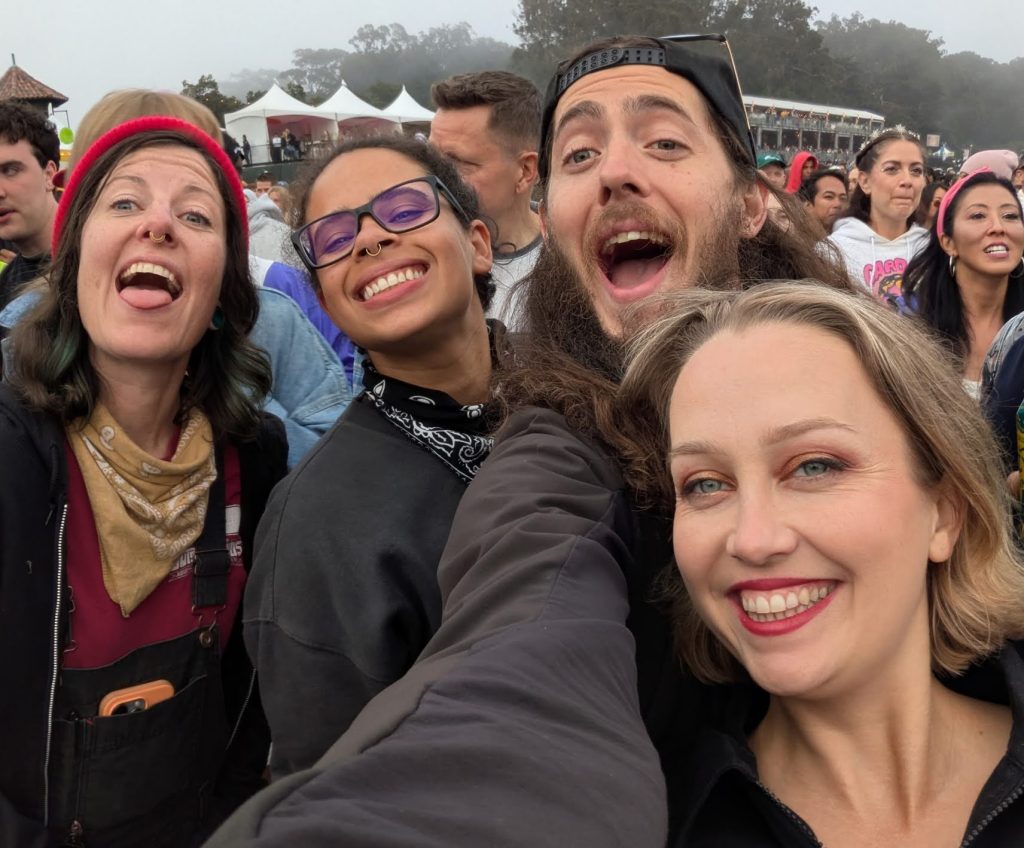
Partners from Another Planet
The promoter/producer for the Outside Lands festival is Another Planet Entertainment. They operate several other Bay Area venues where Rhinos go to work. Does the partnership with APE go beyond just staffing their events?
Jessica: Rhino and APE have been colleagues for many years, we enjoy any project they include us in. Our training efforts are supported by them whenever possible.
Mike: I believe it does. In the office, we go above and beyond to ensure nothing is missed and can anticipate shortcomings, thanks to our years of working together. Our crew has always taken pride in the work they provide and truly cares about the end product of events. We have a dedicated house crew and specialty folks at multiple venues around the Bay Area. They play an integral role in APE’s daily operations.
Sam: Several members of APE’s staff have become dear friends over the years I’ve worked alongside them. There is great comradery between the workers of both companies. Our long-term house crews are definitely consulted on matters beyond simple headcount when they have the relevant experience. For instance, as a member of the Greek Theater’s house crew, I am frequently consulted if there will be a change in the way we are managing the queue for a particular show. All that being said, there are only around 8 positions like that and any matters beyond the day-to-day are APE’s alone.
An Added Challenge
Lastly, in the midst of all the run of days in the Park, you put 25 of your newer employees through the two days of OSHA 10 training. What are you looking forward to for them?
Jessica: Growth, of course. We find that individuals with the training are safer than others and, by doing so, extend their careers.
Mike: Very excited for the new OSHA 10 group. I’m most looking forward to integrating them into the UC Berkeley Greek Theater concerts for some hands-on experience with our veteran crew. Having more OSHA 10s keeps us prepared for anything that comes our way.
Sam: OSHA 10 is an interesting metric to me. While almost anyone can sit in a room for two days, I am always curious to see who not only retains the information but applies it to their workflow even when not being monitored for it. It really helps me to figure out which Rhinos are taking their jobs seriously and are committed to safety.
Read more Rhino team member interviews at the links below.
- Q&A re: Fall Rescue Demo for Firefighters
- Jacob Worek, National Director of Safety
- Carolyn DuRoss Promoted to National Director of Training
- Rhino Florida’s Roman Ivanov Recognized For Outstanding Work At 2024 Miami Grand Prix
- Inside Rhino: Lance Cangey, One of Our Top Trainers
- Inside Rhino: Keno Snyder on Fly System Inspection